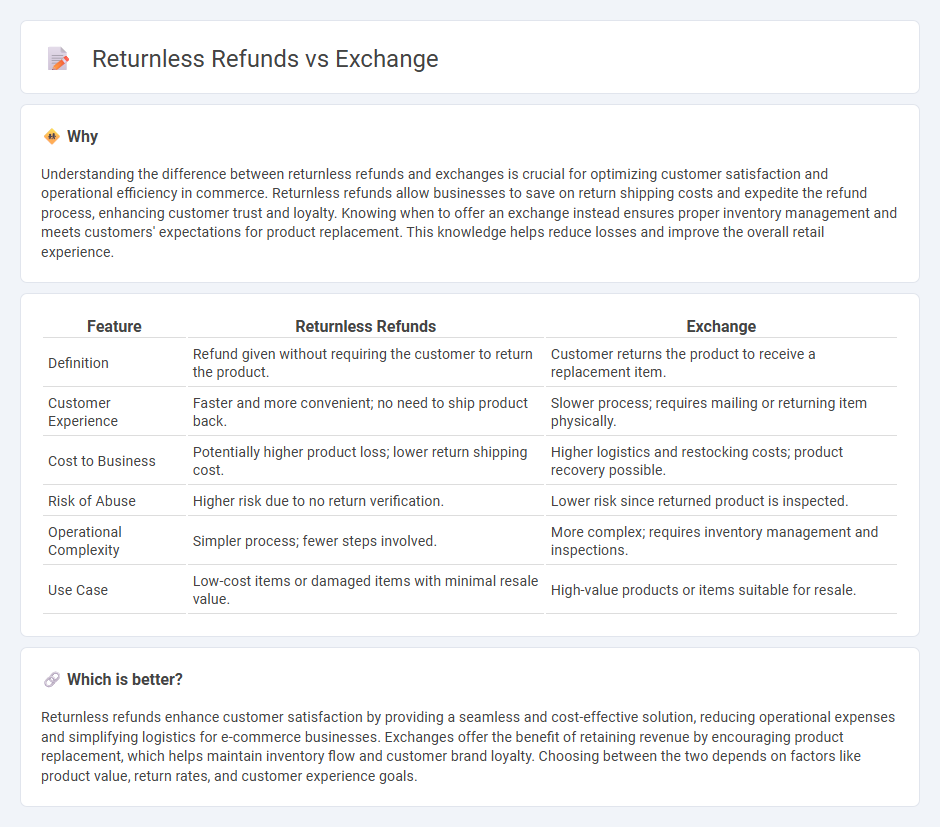
Returnless refunds reduce operational costs by allowing customers to keep products while receiving a full refund, enhancing satisfaction and minimizing reverse logistics. Exchanges involve customers returning items for a replacement, maintaining product lifecycle but increasing handling and shipping expenses for retailers. Explore detailed insights to determine the best strategy for optimizing your commerce returns and customer experience.
Why it is important
Understanding the difference between returnless refunds and exchanges is crucial for optimizing customer satisfaction and operational efficiency in commerce. Returnless refunds allow businesses to save on return shipping costs and expedite the refund process, enhancing customer trust and loyalty. Knowing when to offer an exchange instead ensures proper inventory management and meets customers' expectations for product replacement. This knowledge helps reduce losses and improve the overall retail experience.
Comparison Table
| Feature | Returnless Refunds | Exchange |
|---|---|---|
| Definition | Refund given without requiring the customer to return the product. | Customer returns the product to receive a replacement item. |
| Customer Experience | Faster and more convenient; no need to ship product back. | Slower process; requires mailing or returning item physically. |
| Cost to Business | Potentially higher product loss; lower return shipping cost. | Higher logistics and restocking costs; product recovery possible. |
| Risk of Abuse | Higher risk due to no return verification. | Lower risk since returned product is inspected. |
| Operational Complexity | Simpler process; fewer steps involved. | More complex; requires inventory management and inspections. |
| Use Case | Low-cost items or damaged items with minimal resale value. | High-value products or items suitable for resale. |
Which is better?
Returnless refunds enhance customer satisfaction by providing a seamless and cost-effective solution, reducing operational expenses and simplifying logistics for e-commerce businesses. Exchanges offer the benefit of retaining revenue by encouraging product replacement, which helps maintain inventory flow and customer brand loyalty. Choosing between the two depends on factors like product value, return rates, and customer experience goals.
Connection
Returnless refunds streamline the commerce process by allowing customers to receive refunds without sending products back, reducing return shipping costs and improving customer satisfaction. This approach is closely related to exchanges, where businesses may offer direct product swaps without requiring a return, thereby enhancing operational efficiency. Both returnless refunds and exchanges leverage customer-centric policies to boost loyalty and minimize logistical complexities in e-commerce and retail environments.
Key Terms
Customer Satisfaction
Exchange policies often enhance customer satisfaction by offering immediate product replacement, reducing inconvenience and increasing loyalty. Returnless refunds streamline the process by eliminating return shipping, providing quick relief to customers and lowering operational costs. Explore detailed strategies to optimize your refund and exchange policies for maximum customer retention and satisfaction.
Reverse Logistics
Reverse logistics optimizes supply chain efficiency by managing returns and exchanges seamlessly, reducing costs associated with transportation and restocking. Returnless refunds eliminate return shipping, enhancing customer satisfaction and lowering operational expenses, but may impact inventory management differently compared to traditional exchanges. Explore how these strategies balance cost, customer retention, and inventory control to improve overall reverse logistics.
Policy Compliance
Policy compliance in exchanges versus returnless refunds hinges on adherence to established guidelines ensuring customer satisfaction and minimizing fraud. Exchanges typically require the return of the original product, enabling inventory control and quality checks, while returnless refunds expedite resolution but demand stringent eligibility criteria to prevent abuse. Explore detailed strategies to balance compliance with customer experience in your return management system.
Source and External Links
Army Air Force Exchange Service - The Army & Air Force Exchange Service (AAFES), known as The Exchange, provides retail goods and services to U.S. military installations worldwide including department stores, restaurants, and uniform sales, supporting military quality-of-life programs.
Microsoft Exchange Server - Wikipedia - Microsoft Exchange Server is a mail and calendaring server software by Microsoft, available as on-premises software or cloud-based Exchange Online service for enterprise email and collaboration.
Currency Converter | Foreign Exchange Rates - Oanda - OANDA provides currency conversion services and real-time foreign exchange rates for 212 currencies, offering tools for global money transfers and market rate insights.
 dowidth.com
dowidth.com